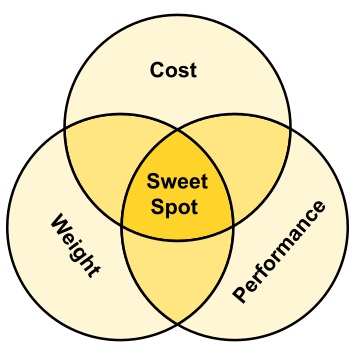How to Save Money on Backpacking Gear

Table of Contents
Trade-off between Weight, Performance (Including Durability), and Cost
The most common mistake of beginners is to underestimate the importance of weight. They try to save money by buying heavy gear but end up wasting money because they later must upgrade to lighter gear.
Through-hikers say, “Ounces make pounds.” They go to great lengths to shave off a few ounces–drilling holes in toothbrush handles, cutting straps off packs, and spending thousands of dollars on ultralight gear. That’s overkill for casual backpackers, but you might find that weight is more important than you expected. A 35-lb pack might not feel heavy when you carry it around your yard, but after lugging it up and down hills for 15 miles, you’ll wish you had bought lighter gear.
Your loaded pack should weigh less than 20% of your body weight. The maximum is 35 lbs for the average, 180-lb American, but the lighter, the better. Long-distance and fast-paced backpackers carry less than 20 lbs.
Another common mistake is to spend too much on ultralight gear that isn’t necessary for your hiking conditions. It’s always good to carry the lightest weight possible, but is it necessary to spend an extra $2,000 on ultralight gear if you are only hiking 5 miles per day on level terrain?
Three Rules of Weight, Durability, and Cost
- Cheap durable gear isn’t light
- Cheap lightweight gear isn’t durable
- Lightweight durable gear isn’t cheap
Sweet Spot
Low-end, High-end, and Sweet-spot Conditions
| Low-end | Sweet Spot | High-end |
|---|---|---|
| • Heavy gear • Less than 5 miles/day • Low elevation gain • Uncomfortable • Warm temperatures • Excellent physical shape • Not far from car | • Moderate to light-weight gear • Less than 15 miles/day • Moderate elevation gain • Comfortable • Temperatures down to freezing • Average physical shape | • Ultralight gear • Up to 30 miles/day • High elevation gain • Very comfortable while hiking • Separate gear for each temperature range |
Example Costs and Weights of Low-end, High-end, and Sweet-spot Gear
| Low-end Product | Weight (oz) | Cost ($) | Sweet-spot Product | Weight (oz) | Cost ($) | High-end Product | Weight (oz) | Cost ($) | |
|---|---|---|---|---|---|---|---|---|---|
| Backpack (55 L) | Bseash 60L | 64 | $40 | REI Flash 55 | 45 | $199 | Hyperlite Mountain Gear Southwest 55 | 32.5 | $379 |
| Tent | Coleman Sundome | 109 | $70 | Lanshan Ultralight 3-Season Backpacking Tent | 45 | $160 | ZPacks Duplex Flex | 28 | $818 |
| Sleeping bag (20°) | SAEROVIE 20° Mummy Sleeping Bag | 64 | $37 | Kelty Cosmic 20 Down | 39 | $120 | Therm-a-Rest Hyperion 20 | 21 | $550 |
| Total | 237 oz | $147 | 129 oz | $479 | 81.5 oz | $1747 |
Five Steps to Save Money on Backpacking Gear
Step 1
Set your total budget
Don’t buy any gear before you’ve set your total budget. A reasonable budget for new gear is $800-$1,000 per person to hike less than 15 miles per day over moderate elevation gains at temperatures above freezing. A lower budget is possible if you buy used gear, hike at temperatures above about 45°F, are in good physical shape, or have a high tolerance for discomfort. If you spend much less than this on new gear, it might be too heavy, uncomfortable, or unsafe for backpacking. Then you’ll have to buy lighter or more suitable gear in addition to what you’ve already bought.
Step 2
Identify your hiking conditions
| Weather | You might need… |
|---|---|
| Cold (temperature freezing or below) | • 4-season tent • Sleeping bag with low extreme rating (0° F, etc.) • Sleeping pad with R-value of at least 4 (or 2 sleeping pads with R-values of at least 2) • Special warm clothing (synthetic or wool base-layer top/bottom, beanie, balaclava, gloves, insulated boots, thick puffy jacket with high fill power and fill weight) • Backpack volume 60 L or more to hold bulky winter gear • Backpack with rigid load support and thickly padded belt and shoulder straps to comfortably carry heavy winter gear |
| Hot | Light, breathable long-sleeve shirts and pants for protection against sun, poison ivy, mosquitoes, and ticks |
| Rain or high humidity | • Double-walled tent to manage condensation • Sleeping bag and puffy jacket containing synthetic instead of down insulation • Rain gear |
| Windy | • Wind-resistant tent • Rain pants and rain jacket instead of a rain poncho • Windbreaker |
Elevation You might need …
Large changes in elevation Ultralight gear
High elevation (low oxygen) Ultralight gear
| Terrain | You might need… |
|---|---|
| Rocky or sandy | Freestanding tent |
| Thick understory and sturdy trees | Backpacking hammock instead of a tent |
| Muddy or slippery | • Footwear with good traction • Trekking poles |
| Stream crossings | • Quick-drying trail-running shoes • Convertible pants • Trekking poles |
| Ice | • Crampons • Trekking poles |
Number of hikers in your party You might need…
1 1- or 2-person tent
2 2- or 3-person tent
etc. etc.
Hiking duration You might need…
1 or 2 days Pack volume 55L or less
3 days or more Pack volume 60L or more
Miles per day You might need…
10 miles or more • Ultralight gear
• Trail-running shoes
Physical condition You might need…
You – poor physical condition Ultralight gear
Your hiking partner(s) – poor physical condition Pack volume 60L or more to carry some of your partner’s gear
Wildlife You might need…
Bears • Bear canister (may determine backpack volume)
• Bear spray
Ticks • Permethrin
• Long pants
• Long-sleeved shirt
Mosquitoes • DEET
• Long pants
• Long-sleeved shirt
Venomous snakes High, thick leather boots if bushwacking
Consider whether to emphasize hiking or camping. Most backpackers lie somewhere between the following two extremes:
Camping Extreme Hiking Extreme
• Hike only so you can camp (you would avoid hiking if you could)
• Low mileage
• Gear materials heavy, bulky, durable, and inexpensive
• Spacious, double-wall, freestanding tent
• Luxury items (chair, lantern, hammock, coffee maker, etc.)
• Gear for fire-building, cooking, or bushcrafting (hatchet, saw, frying pan, etc.)
• Gear for leisure (fishing pole, swim trunks, book, journal, harmonica, deck of cards, etc.)
• Food selected for flavor and complete nutrition
• Low total cost
• Camp only so you can hike (you would avoid camping if you could)
• High mileage
• Gear materials light, fragile, and expensive
• Cramped, single-wall, non-freestanding tent
• Items only for bare-minimum survival
• Food selected for low weight, low bulk, high calories, and quick preparation
• High total cost
Step 3
Choose your tent, sleeping bag (or top quilt), sleeping pad, and footwear
Don’t skimp on these. Spend enough to meet your hiking conditions from Step 2. It can be hard to overcome the sticker shock of these items, but if you don’t spend enough on them, you’ll end up having to upgrade and spend even more.
Try not to exceed these weights:
- Tent (2-person trail weight): 4 lbs
- Sleeping bag (down): 2 lbs
- Sleeping bag (synthetic): 3 lbs
- Sleeping pad: 1 lb
Don’t purchase the gear yet. Keep a running tally of total weight based on the product specifications. You can use this app: lighterpack.com
Learn about Step 3 Gear
Beginner’s Guide to Tents for Backpacking
Beginner’s Guide to Sleeping Bags and Quilts for Backpacking
Beginner’s Guide to Sleeping Pads for Backpacking
Beginner’s Guide to Footwear for Backpacking
Buy Step 3 Gear
Budget Backpacking Tents, Hammocks, Other Shelters, and Accessories
Budget Sleeping Bags, Quilts, and Liners for Backpacking
Step 4
Choose the remaining gear, except the backpack
Examples: Trekking poles, stove, water filter, cookware.
You don’t need to spend much on these items. You might not even need them! Don’t use all of your remaining budget on them; leave about $300 for a backpack and non-durable goods such as stove fuel. If you’re unable to save this much, you’ll need to either lower the cost of your Step-4 gear or adjust your budget.
The small stuff adds up. Resist the temptation to buy gear you don’t need, no matter how small, light, and inexpensive. Ask yourself, “Is it possible to backpack safely and reasonably comfortably without it?” If the answer is “yes,” don’t buy it.
After you’ve selected all of the gear except your backpack, calculate the total weight. If it’s more than 20% of your body weight, eliminate non-essential items or increase your budget to buy lighter gear from Steps 3 and 4.
Once you’ve dialed in the budget and weight, purchase all of the gear except the backpack.
Don’t rush! It takes at least a year to find used gear, win Ebay auctions, and wait for annual discount sales. Until then, try to borrow gear or use whatever substitutes you already have.
Learn about Step 4 Gear
Beginner’s Guide to Trekking Poles
Beginner’s Guide to Backpacking Stoves
Beginner’s Guide to Water Filters and Purifiers for Backpacking
Buy Step 4 Gear
Step 5
Choose Your Backpack
Choose the backpack last because its volume and weight capacity will depend on the weight and volume of your other gear, including heavy, bulky gear for cold weather.
If possible, bring all of your gear to an outdoor shop, and try on each backpack with all of the gear inside. Once you’ve chosen the backpack, wait until you can find it used or on sale.
Along with the tent and sleeping bag, the backpack is one of the “Big Three” that you shouldn’t skimp on. If you followed Step 4 correctly, you should have enough money left for the backpack you need.
43 Tips for Saving Money on Backpacking Gear
Sign up for a free copy of 43 Tips for Saving Money on Backpacking Gear.

